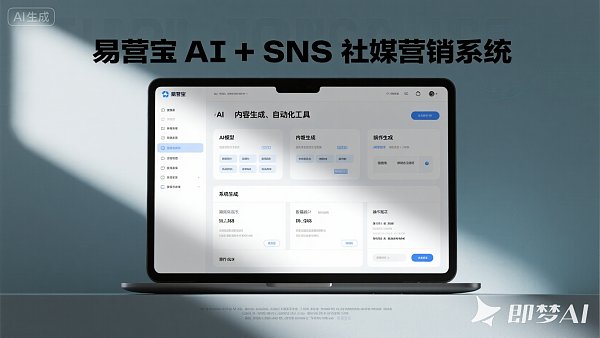Easy Camp Cloud Intelligent Website Construction and Marketing System Platform!
Definition of Social Platforms: Online Communities Based on User Interaction and Content Sharing
Social Media Platforms are online services or applications that leverage internet technology, enabling users to create personal profiles, publish and share content (text, images, videos), and engage in real-time interactions and social networking with other users.

Core Elements of Social Platforms:
User Profiles: Allow users to establish unique digital identities.
Content Sharing: Support users in publishing and consuming various forms of content.
Interaction Mechanisms: Provide features like likes, comments, shares, and private messaging.
Social Networks: Build and maintain relationships through mechanisms like "following/followers" and "friends."
The Essence of Social Platforms: A decentralized media network driven by user-generated content (UGC).
Four Major Types of Social Platforms:
The Evolution of Social Platforms: From Desktop to Mobile, Text to Video
The development of social platforms reflects technological advancements, the mobile revolution, and evolving user demands, transitioning from connecting people to connecting content.
1. Early Stage: The Dawn of Digital Socializing (1997–2004)
Technological Features: Represented by Six Degrees and MySpace, primarily desktop-based with simple functionalities like friend lists and basic messaging.
Limitations: Slow network connections, low interactivity, and limited content formats (mainly text).
2. The Golden Age of Social Networks (2004–2010):
Milestones: The rise of Facebook, emphasizing real-name systems, authentic social relationships, and news feeds. Twitter pioneered short-text, real-time information dissemination.
Impact: Social platforms shifted from personal hobbies to essential daily tools, accumulating vast user data.
3. Mobileization and Visual Trends (2010–2017):
Key Driver: Smartphone adoption propelled platforms toward mobile-first experiences.
Platform Emergence: Instagram (images) and Snapchat (ephemeral sharing) capitalized on visual content and immediacy.
Monetization: Platforms introduced sophisticated advertising systems, enabling large-scale commercialization.
4. Algorithm-Driven and Short-Video Boom (2017–Present):
Technological Core: Recommendation algorithms shifted from "social graphs" to "interest graphs" (e.g., TikTok’s success).
Content Revolution: Short videos dominate, with users demanding faster consumption and higher quality.
Trends: Platforms extend into e-commerce, live shopping, and the metaverse, blurring traditional boundaries.
Technical Principles of Social Platforms: Algorithm-Driven and Data Connectivity
Modern social platforms compete through powerful recommendation algorithms and deep user data mining.

1. Core Technology: Recommendation Algorithms
Principle: Algorithms (often using deep learning and collaborative filtering) determine what content users see.
Two Schools:
Social Graph: Prioritizes content from friends or followed accounts (early Facebook).
Interest Graph: Recommends content aligned with user interests, not just connections (TikTok, YouTube), based on interaction history, dwell time, and search data.
Goal: Maximize user engagement and boost ad click-through rates.
2. Data Collection and User Profiling
Data Sources: Platforms collect on-site actions (clicks, views, searches, posts) and off-site behavior (via Pixel/Cookie tracking).
Value: Enables hyper-detailed user profiles, essential for precision ad targeting.
3. Content Moderation and Safety
Implementation: Combines AI and human review to automatically detect violations (e.g., violence, explicit content, copyright issues).
Goal: Maintain platform integrity, mitigate risks, and ensure stable operations.
4. Viral Propagation Mechanism
Principle: Algorithms allocate initial exposure (small traffic pool) to new content. High engagement/completion rates trigger exponential distribution (go viral).
Technical Features and Core Application Advantages of Social Platforms
Social platforms have become vital for brand marketing, public opinion guidance, and business transformation.
1. Discovery Marketing Beyond Search
Feature: Users are in a relaxed and open state.
Advantage: Brands can leverage creative content and precise targeting to spark latent needs without active searches.
2. Precision User Targeting and Ad Delivery
Feature: Ad systems (e.g., Meta Ads, TikTok Ads) allow granular targeting by interests, behavior, age, and location.
Advantage: Ads efficiently reach target audiences, maximizing return on ad spend (ROAS).
3. Brand Personalization and Interactivity
Feature: Platforms demand brands engage users in a "personalized" and "authentic" manner.
Advantage: Through comments,话题 creation, and behind-the-scenes content, brands build emotional connections and loyalty—unmatched by traditional media.
4. Rapid Content Iteration and Testing
Feature: Content creation has low barriers and short cycles (especially short videos).
Advantage: Brands can quickly test creatives, copy, and selling points, adjusting strategies based on real-time data.
5. Public Sentiment Monitoring and Crisis PR
Feature: Platforms are sources and amplifiers of public opinion.
Advantage: Critical for sentiment tracking, understanding user feedback, and rapid crisis response.
Advanced Applications and Marketing Strategies for Social Platforms
Effective platform use requires differentiated, data-driven, and interaction-centric strategies.

1. Marketing Funnel and Content Layering
Top Funnel (Awareness): Deploy engaging, brand-aligned short videos for low-cost maximum exposure.
Mid-Funnel (Interest/Consideration): Publish in-depth图文, live Q&A, or KOL/KOC reviews to guide traffic to official sites.
Bottom Funnel (Conversion): Retarget users who browsed product pages with limited-time offers or high-conversion copy.
2. KOL/KOC Marketing Strategy
Strategy: Partner with Key Opinion Leaders (KOLs) and Key Opinion Consumers (KOCs) to leverage their trust and niche influence.
Value: Compared to direct ads, KOL/KOC endorsements offer higher credibility and better conversions.
3. Social SEO
Strategy: Optimize for platform-native search (e.g., hashtags, keywords, geotags on Instagram/TikTok).
Value: Ensures users find your accounts/content via in-platform searches.
4. Ad Data and Website Data Integration
Strategy: Deploy Facebook Pixel/TikTok Pixel and Conversions API (CAPI) to sync ad clicks with website purchases/inquiries.
Value: Precise tracking accelerates AI learning, improving ad efficiency.
5. Community Operations and Private Traffic
Strategy: Redirect public traffic to private communities (e.g., WeChat groups, Discord, Telegram).
Value: Builds owned, repeatable, high-loyalty customer networks, reducing platform dependency and boosting lifetime value (LTV).
EasyGrowth: Your Full-Funnel Social Platform Growth Expert
EasyGrowth understands social platforms as powerful engines for rapid brand growth. Our services are systematic solutions based on global algorithm insights, creative content strategies, and precise data attribution.

Platform Strategy and Positioning: Analyze your audience’s most active platforms and craft differentiated content strategies and brand personas.
High-Conversion Ad Deployment and Optimization: Focus on ROI-driven optimization for Meta Ads/TikTok Ads, ensuring maximum returns.
Content Creativity and Viral Propagation: Combine trends and algorithmic preferences to plan high-engagement, shareable content.
Data Attribution and CAPI Deployment: Ensure all ad data is accurately tracked via Conversions API, empowering AI bidding.
KOL/KOC Matching and Management: Identify and manage ideal social influencers based on your budget and market goals.
Choose EasyGrowth to transform your social platform operations from盲目跟风 to data-driven, goal-oriented, and predictable growth strategies.
FAQ
1. Which is more important: social media traffic or Google SEO traffic?
The two complement each other, but their functions differ:
Social media traffic: excels at discovery marketing (stimulating latent demand), rapidly building brand awareness , and testing creative ideas . It's **"selling"**.
Google SEO traffic excels at capturing clear, high-intent buying demand . It's **"lead generation" . ** Optimal strategy: Utilize social media platforms to quickly build brand awareness and interest; leverage Google SEO to fulfill the final conversion needs .
2. Why is my content highly engaging but has a low conversion rate?
This is usually a problem of content not matching objectives , i.e., a gap in the marketing funnel :
Entertainment overemphasis: Your content may be too focused on entertainment or humor . While it may have garnered a lot of likes and shares, it has failed to effectively highlight the product value or call to action (CTA) .
Poor landing page experience: Even if users click on the ad, slow loading speeds, complex purchase processes, or insufficient trust indicators on your landing page can lead to user churn. Solution: Ensure a clear value proposition consistency between your content and ad copy and the landing page , and optimize the landing page's conversion rate (CRO).

Customer Reviews
Mr. Yan, founder of a D2C consumer electronics brand
"Our previous social media platform operations were stuck at the 'posting' stage, with obvious traffic bottlenecks. The Yiyingbao team developed a viral content strategy for us, combining short videos and live streaming , and focused on optimizing the tROAS target of Meta Ads . Most importantly, they helped us deploy CAPI , solving the data attribution problem under the iOS privacy policy. Now, our social media platform is not only a window to our brand image, but also a high-ROI sales channel , with a stable ROI of over 3.8% for ad spend ."
Ms. Ding, Marketing Manager of a B2B Industrial Service Platform
"As a B2B company, we lacked direction in utilizing social media platforms. EasyPro guided us to focus on LinkedIn and specialized vertical communities (such as Reddit) instead of blindly pursuing large traffic volumes. They helped us create in-depth content addressing industry pain points and targeted executives and purchasing decision-makers through precise LinkedIn ad targeting . The quality of our B2B leads has significantly improved , and social media platforms have become one of our most efficient B2B customer acquisition channels ."
 How Did the APP Lurking in 1 Billion Bosses' Phones Help 52% of B2B Companies Achieve Annual Revenue of Tens of Millions? (Part 1)Exploring How LinkedIn, the World's Premier Professional Network, Empowers B2B Companies to Efficiently Engage Decision-Makers and Achieve Tens of Millions in Annual Revenue! Precision Targeting, Exceptional Conversion Rates, and Unmatched Credibility—Unlocking LinkedIn's Business Growth Strategies.
How Did the APP Lurking in 1 Billion Bosses' Phones Help 52% of B2B Companies Achieve Annual Revenue of Tens of Millions? (Part 1)Exploring How LinkedIn, the World's Premier Professional Network, Empowers B2B Companies to Efficiently Engage Decision-Makers and Achieve Tens of Millions in Annual Revenue! Precision Targeting, Exceptional Conversion Rates, and Unmatched Credibility—Unlocking LinkedIn's Business Growth Strategies. The App Where Billionaires Hide! How 52% of B2B Business Owners Earn Tens of Millions Yearly with It? (Part 2)Master LinkedIn ad strategies, dodge common mistakes, and learn how 52% of B2B entrepreneurs make tens of millions annually! Tailoring, bidding, and content are crucial to converting decision-makers and revolutionizing targeted B2B lead generation.
The App Where Billionaires Hide! How 52% of B2B Business Owners Earn Tens of Millions Yearly with It? (Part 2)Master LinkedIn ad strategies, dodge common mistakes, and learn how 52% of B2B entrepreneurs make tens of millions annually! Tailoring, bidding, and content are crucial to converting decision-makers and revolutionizing targeted B2B lead generation. Annual revenue exceeding 10 million, transitioning from auto parts to energy storage, niche markets achieve major sales! (Part 2)Exploring how Datou Hardware Products Co., Ltd. successfully pivoted from auto parts to energy storage by establishing the standalone brand website DATOU BOSS and implementing precise marketing strategies to expand overseas markets, achieving annual revenue exceeding 10 million.
Annual revenue exceeding 10 million, transitioning from auto parts to energy storage, niche markets achieve major sales! (Part 2)Exploring how Datou Hardware Products Co., Ltd. successfully pivoted from auto parts to energy storage by establishing the standalone brand website DATOU BOSS and implementing precise marketing strategies to expand overseas markets, achieving annual revenue exceeding 10 million. How can domestic travel agencies acquire customers through Google? What are the operational steps?Domestic travel agencies looking to expand their client base through Google? This article provides a four-step operational guide, including precise ad placements, Google Maps client development, advanced search command filtering, and remarketing for converting potential clients, helping travel agencies effectively utilize Google for customer acquisition.
How can domestic travel agencies acquire customers through Google? What are the operational steps?Domestic travel agencies looking to expand their client base through Google? This article provides a four-step operational guide, including precise ad placements, Google Maps client development, advanced search command filtering, and remarketing for converting potential clients, helping travel agencies effectively utilize Google for customer acquisition.










